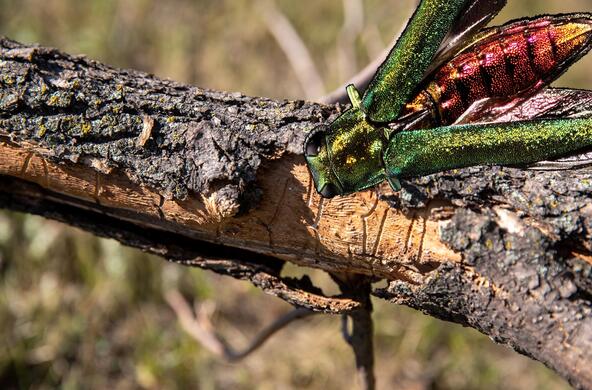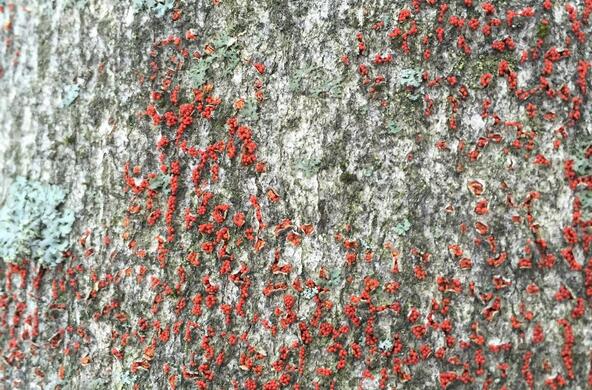It’s hard to describe the feeling of being in an old-growth hemlock forest. The trees are large, up to three feet across, and may be hundreds of years old. The canopy is dense and casts a deep shade, making the air below cool and moist. Because of the deep shade, there are very few saplings or ground plants, and the accumulation of dead needles makes the forest floor springy underfoot. The dark and cool and quiet lends the forest a cathedral-like atmosphere.
This is a feeling that I am afraid my grandchildren, should I ever have any, will never know. Ironically, the giant hemlock trees that create this environment are threatened by a tiny bug called the hemlock woolly adelgid. Accidentally imported from Asia into the eastern U.S. in the 1950s, the adelgid spread through the mid-Atlantic States and reached our area several years ago.
The little insect, which is related to an aphid, settles at the base of hemlock needles and sucks nutrients from the tree. It multiplies rapidly and covers itself in a woolly mass, which is visible on the underside of twigs in the fall, winter, and spring. Large infestations always seem to result in tree death, so the prognosis for the hemlock population is not good.
This is not the first time hemlocks have been in trouble. By examining pollen grains preserved in sediment taken from the bottom of lakes and bogs, and using an aging technique called carbon-dating, scientists have been able to establish plant growth patterns that date back thousands of years. Pollen studies in our region tell us that after the glaciers retreated some 12,000 years ago, forests began to colonize the newly ice-free space. Hemlocks were a dominant tree species in post-glacial forests. Then, about 5,000 years ago, their pollen nearly disappeared from the sediments.
The reason for this decline is still being debated, but in the same sediment layers scientists also discovered the remains of the hemlock looper, an insect that feeds on hemlock trees. Some scientists think the looper killed the hemlocks, while others think that climate changes caused both the hemlock decline and the looper outbreak. We’ll probably never know for sure. We do know that the hemlocks eventually recovered, but it took about a thousand years.
People caused the next assault on hemlocks. In the mid 1800s, their tannin-rich bark formed the base of a thriving leather tanning industry. Many current Catskill towns, such as Phoenicia and Tannersville, started out as tanning mills. Millions of hemlock trees were cut; their bark was stripped and hauled on sleds to tanning mills, where it was added to large vats for tanning hides. In the process, most of the hemlock trees in the Catskills were destroyed. By the end of the 1800s, all the readily accessible hemlocks had been cut, and new methods of tanning with metals were developed.
The hemlocks in the Catskills and Hudson Valley have been recovering from the tanning devastation for the last century, only to be confronted with the hemlock woolly adelgid. Our area is currently at the northern end of the pest’s range, because it is sensitive to cold temperatures. However, our winter climate is becoming milder, and at the same time the insect is evolving greater cold tolerance. In time, it seems likely that the insect will spread throughout the entire hemlock range.
Like many forest pests, the adelgid was imported to our country through foreign trade. The list of foreign invaders currently assailing our forests is daunting. Ash trees are being killed by the emerald ash borer, beech trees are declining due to the beech bark disease, dogwoods are being decimated by the dogwood anthracnose fungus, and many species of hardwood trees are threatened by the Asian longhorned beetle.
The two most important pathways of entry into the country for these pests are wood-packing materials such as pallets and importation on live plants in the nursery trade, which is how the hemlock woolly adelgid got here. The regulations governing such imports are inadequate and the port inspection program is overwhelmed and underfunded.
The government agency charged with overseeing these imports (The Animal and Plant Health Inspection Service, or APHIS) has just proposed a new rule that would help the situation substantially. Current regulations allow importation of any plant or insect as long as it is not known to be invasive itself or to harbor noxious pests. The new rule would create a separate category for those imported plants for which the risk is unknown.
Plants in the “unknown risk” category could not be imported until a risk analysis has been done, and the plant has been placed on the list of approved plants. By allowing APHIS the time to assess the risk of potentially dangerous imports, the new ruling may help prevent the next introduction of a serious pest like the hemlock woolly adelgid.
The proposed rule is open for public comment until October 21, 2009. Anyone concerned about the future of our trees should take this opportunity to comment in favor of the proposed regulation. Our grandchildren will appreciate it.







